1) Learn how to spot sugar
Sugar is the simplest form of carbohydrate – the others being fibre and starch, which are longer chain molecules.
Natural (intrinsic) sugar exists in certain foods like fruit and milk. Added (free) sugars have been added to foods during manufacturing in products like biscuits and ice-cream.
Sugar takes several different forms. Glucose, fructose, and sucrose are all types of sugar.
Glucose is the body’s preferred carb source and is made up of one single unit of sugar.
Similarly, fructose is a single unit of sugar known as ‘fruit sugar’. Sucrose is a combination of glucose and fructose and is simply the scientific name for basic table sugar.
As well as different forms of sugar, there are many other names for added sugar. This means sugar can be disguised as all kinds of product ingredients in supermarkets. Keep your eyes peeled for:
- Maltose
- Honey
- Molasses
- Maple syrup
- Juice
- High-fructose corn syrup
- Cane sugar
- Dextrose
- Invert sugar
- Rice syrup
- Caramel
Key point:
- Sugar is the simplest form of carbohydrate.
- Intrinsic sugars are naturally present, but free sugars get added during processing.
- Sugar hides in many shop-bought products under different names.
2) Use food labels
It can be extremely overwhelming to be in the supermarket trying to make healthy choices. Food labels are the easiest way to judge which products have too much sugar.
Here is a simple strategy to help you move from high-sugar options to lower-sugar options.
Firstly, when presented with a food label, we typically have two columns to focus on: (1) Quantity per serving and (2) Quantity per 100g.
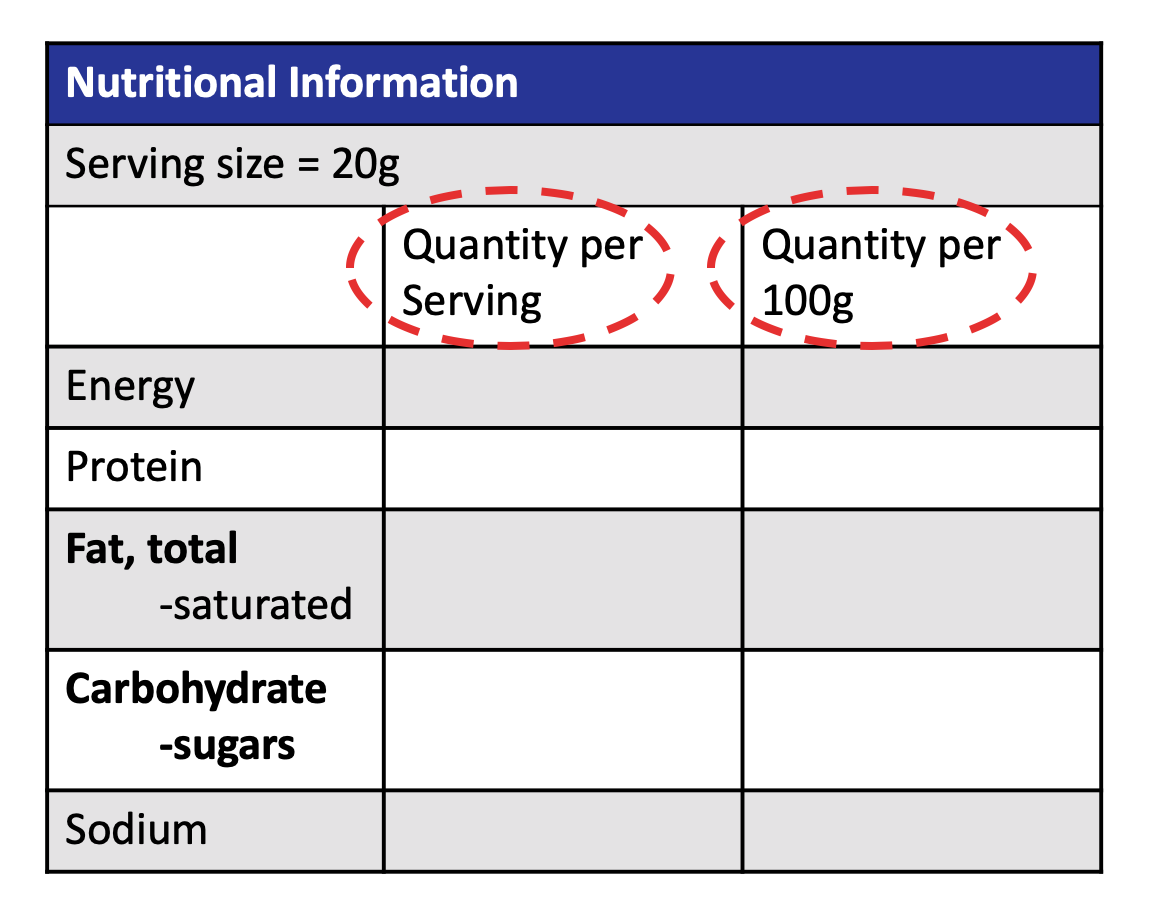
The ‘Quantity Per Serving’ column can be misleading, as manufacturers tend to make a conservative guess of the average amount people eat in one sitting.
For example, a small tub of yoghurt may be two ‘servings’ when in fact, you would usually eat the whole tub at once.
This is where the ‘quantity per 100g’ column is useful. This column will allow you to work out what percentage of that food is sugar. Illustrating this:
- If a food has 50g of sugar per 100g, it’s 50% sugar.
- If it has 30g of sugar per 100g, then it’s 30% sugar.
- If it has 3.2g of sugar per 100g, then it is around 3% sugar.
The key to a low-sugar diet is to go for foods that contain less than 5% sugar (i.e. less than 5g of sugar per 100g of food).
The recommended daily amount of added sugar for adults is 30g daily. This adds up to roughly 7.5 teaspoons of sugar.
Surprisingly, some foods considered ‘healthy’ contain nearly our recommended daily amount of sugar.
For example, an average 250ml glass of orange juice contains around 22g of sugar (roughly six teaspoons). These foods should be avoided when trying to reduce your sugar intake.
Here’s an example of how to choose foods with less than 5% sugar by looking at the food labels:

By changing from fat-free mayo (22.5% sugar – highlighted in red) to whole egg mayo (2.1% sugar – highlighted in green), you can reduce the amount of sugar eaten by over ten times.
Remember that this value does not differentiate between naturally occurring and added sugars, so remember to always compare foods like for like, i.e. yoghurt with yoghurt, or bread with bread. Choose the product with the lowest sugar content per 100g.
Key points:
- Read food labels to determine the sugar content of foods.
- Choose foods with less the 5g of sugar per 100g of food.
- Compare products like for like to pick the one with the least sugar.
3) Avoid low-fat
The example above demonstrates that fat is usually replaced with sugar in low-fat dairy products to maintain taste and texture.
A common myth is that fat makes you fat. However, there are different types of fats. Healthy fats, like extra virgin olive oil, have many health benefits.
While full-fat products provide more energy than low-fat, they typically contain fewer free sugars, and you will need to eat less to feel satisfied and full for longer.
This means you’ll be less likely to experience sugar cravings between meals.
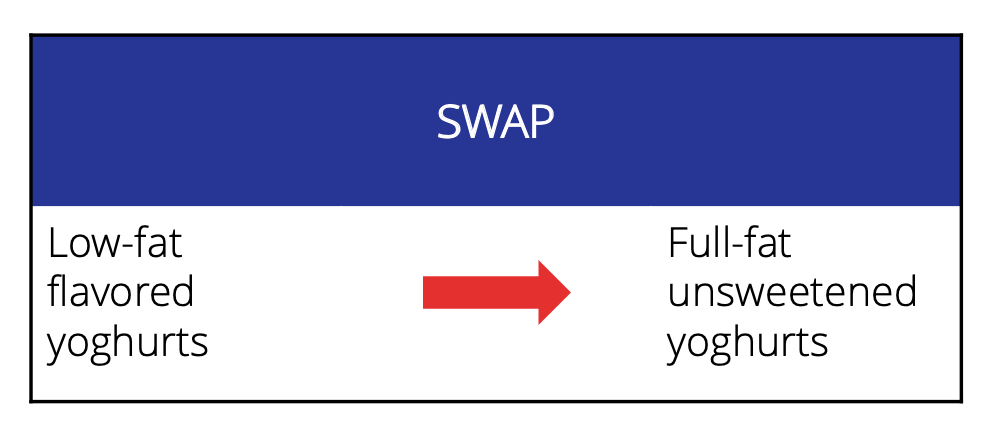
Key point:
- Low-fat options often contain more sugar and might have sugar added to them to make them taste better.
4) Eat whole foods
Natural, whole foods contain no added sugar as they undergo minimal processing (if any). Some examples include beans, lentils, vegetables and brown rice.
While they may contain natural sugar like fruit, they also usually have more fibre, which keeps you feeling fuller for longer.
When you include carbs in your meals, opt for whole-grain versions. Certain whole grain carbs, like rye bread, also result in a lower spike in blood sugar levels compared with refined carbs, such as white bread and breakfast cereals, which long-term may prevent type 2 diabetes.
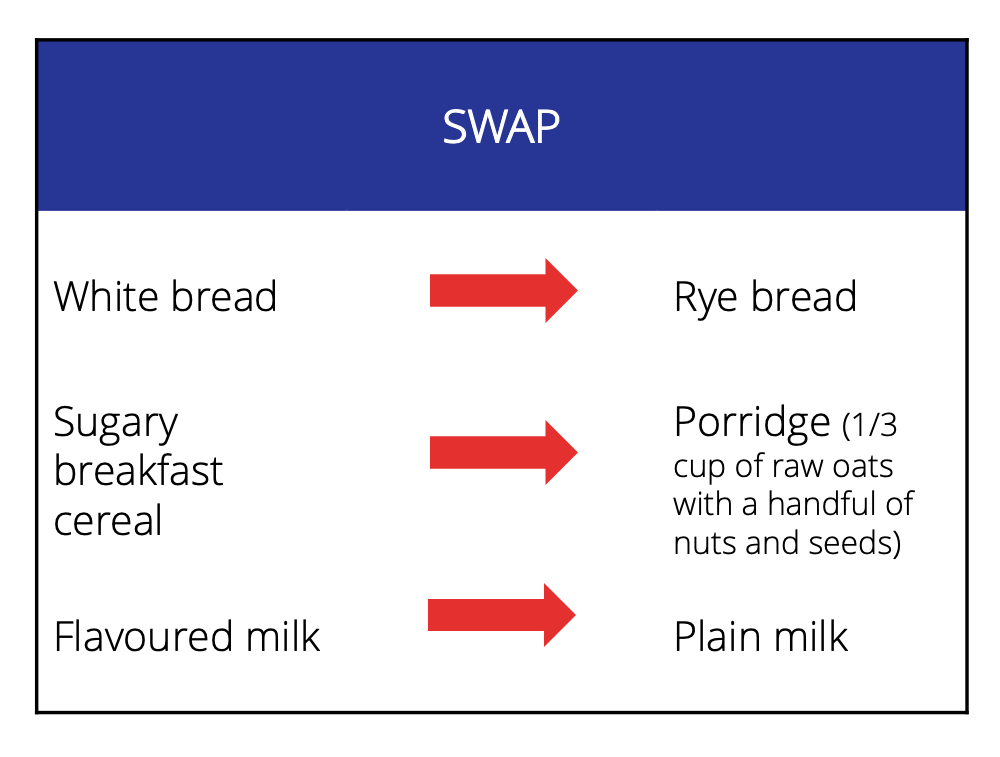
Key point:
- Foods that haven’t been processed much (or at all) won’t contain added sugar.
5) Avoid sugar-sweetened drinks
Fruit juice and fizzy drinks are examples of sugar-sweetened beverages. These drinks are the main factor linked to weight gain in teenagers – this age group tends to drink the highest volume of sugary drinks.
Research published by the British Association for Nutrition suggests a link between soft drink consumption and type 2 diabetes risk.
Avoid swapping these drinks for sugar-free alternatives, such as diet coke. The evidence is mixed but suggests that artificial sweeteners may stimulate our appetite and alter our taste for sweet foods, making cravings more likely.
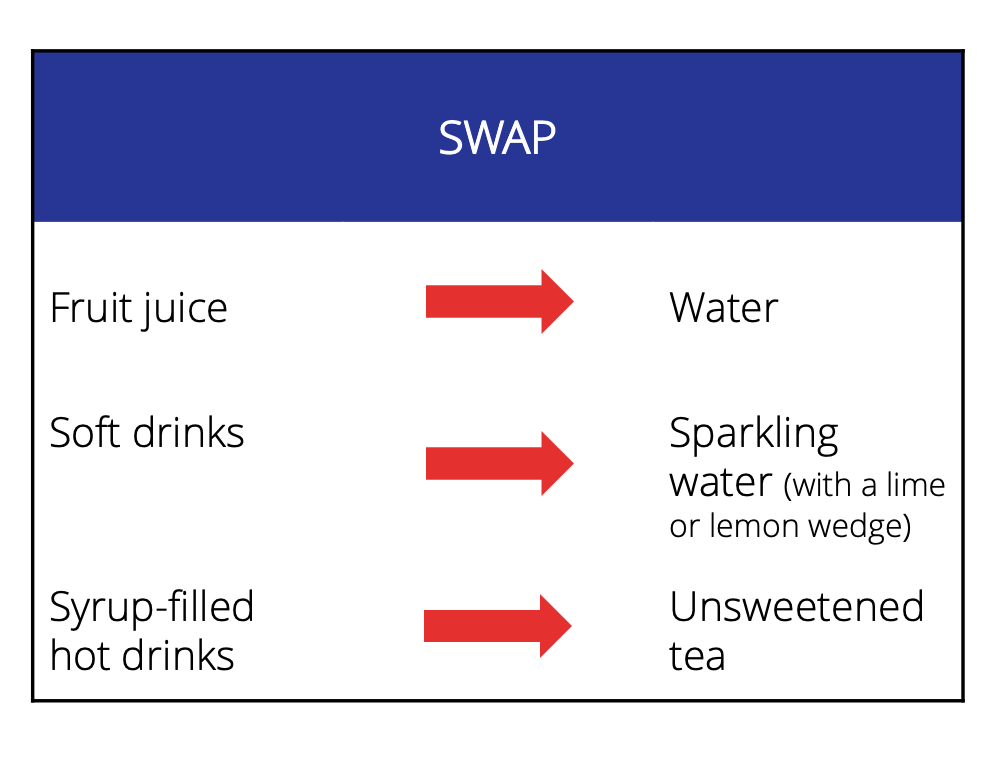
Key point:
- Sugar-sweetened drinks dramatically increase your sugar intake.
6) Meal plan
Planning your food ahead means you are much less likely to buy a quick, convenient meal loaded with hidden sugar.
By planning, you won’t be stuck when you are hungry with nothing but chocolate bars from the office vending machine.
Try cooking a large batch of something at the beginning of the week – you can then serve it with different sides to mix things up. You’ll also find this is a much cheaper way to eat healthily.
The qualified dietitians and nutritionists here at Second Nature have created an example 7-day diet plan, which is low in sugar but high in flavour!
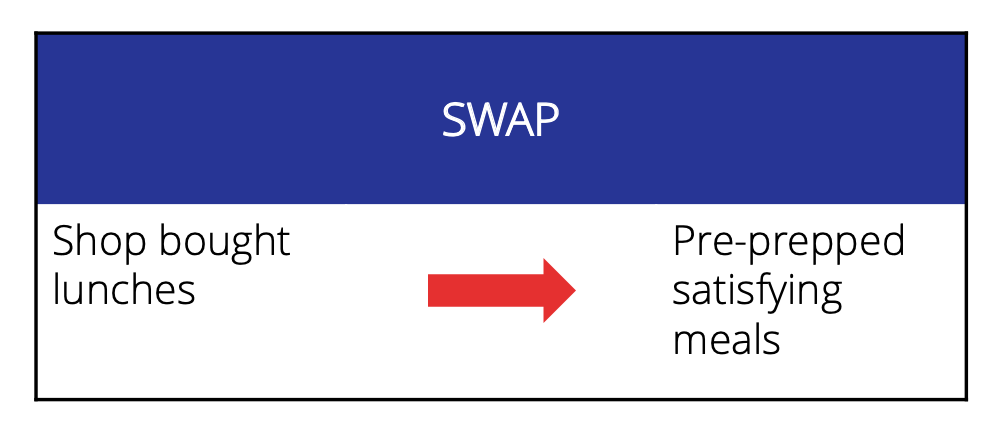
Key point:
- Plan your meals ahead to avoid having to buy meals out with a mystery sugar content.
7) Be snack smart
Snacks can be a significant contributor to sugar in our diet. Biscuits, pastries and even seemingly healthy granola bars contain vast amounts of the sweet stuff. Try opting for snacks with less sugar to reduce your total daily sugar intake.
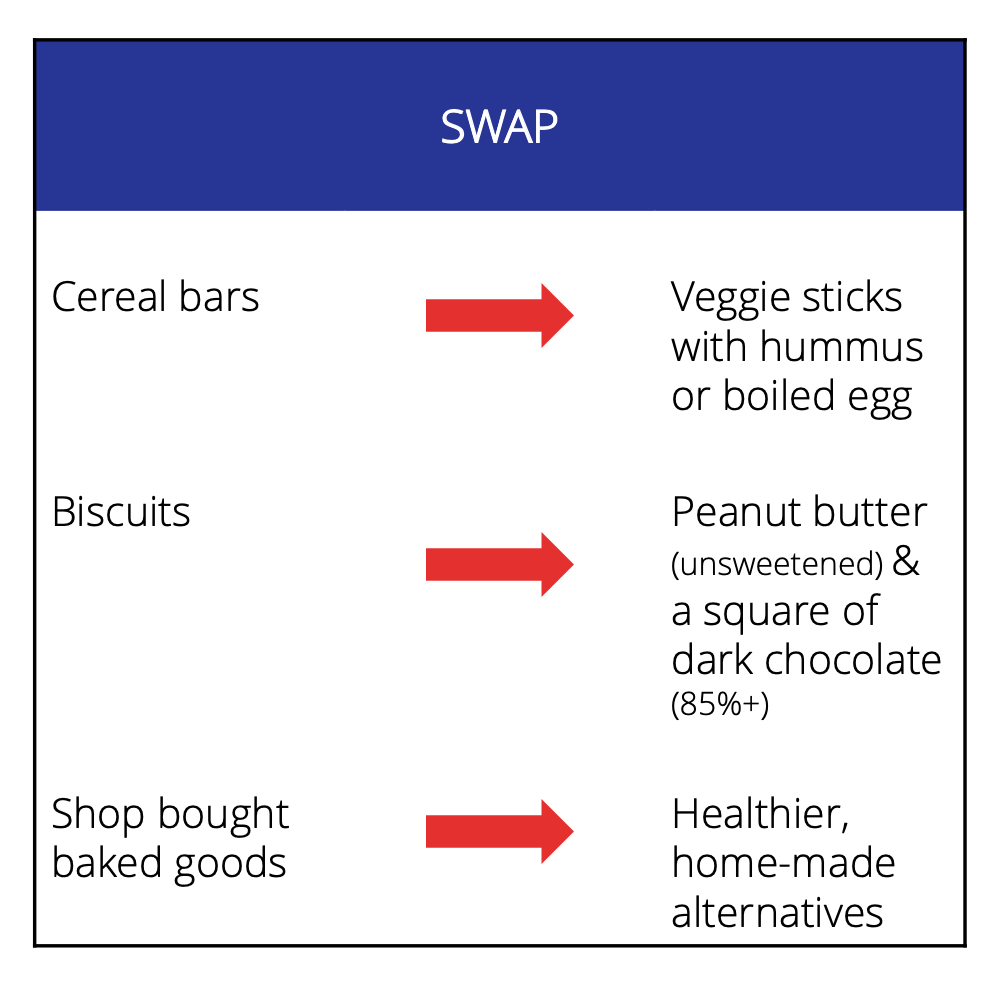
Key point:
- Chose low-sugar snacks to decrease your overall sugar intake.
8) Sleep more
It may seem obvious that we tend to eat more when we feel tired. Running low on energy from a lack of sleep makes us crave this energy in a new form – food.
Evidence also suggests that sleep restriction influences our tastes in certain foods.
In a study exploring the link between sleep and diet in teenagers, sleep restriction led to increased intake of food and in particular sweet foods and desserts.
Try going to bed 30 mins earlier than usual to prevent feeling tired and leaning towards unnecessary sweet treats.
Key point:
- Sleep restriction makes us crave sweet foods more.
Take home message
- You don’t need to eat a completely sugar-free diet to be healthy. But lowering our sugar intake by eating more whole foods will help us lose weight and be healthier.
- High-sugar diets have been linked to the development of obesity, heart disease, and type 2 diabetes.
- Sugar can hide under many different names in shop-bought products.
- Aim for foods with less than 5g of sugar per 100g of food.
- Compare foods like for like to choose the lower sugar option
- Avoid low-fat and ultra-processed foods.
- Avoid sugary beverages, as they dramatically increase your sugar intake.
- Plan your meals and snacks to avoid having to choose sugary options.
- Sleep more to reduce cravings for sweet foods.



